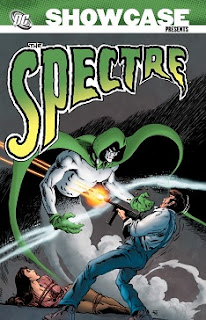Showcase Presents The Spectre Volume 1: written by Gardner Fox, Neal Adams, Steve Skeates, Michael Fleisher and others; illustrated by Murphy Anderson, Jerry Grandenetti, Neal Adams, Jim Aparo, Jim Starlin and others (1966-1983; collected 2012): The first collection of the Spectre's Silver- and Bronze-Age adventures at DC Comics is quite a bargain at over 600 pages for less than $20. It's also a bargain because of the 20-year period spanned by the collection. It's like a miniature cross-section of DC Comics in three different decades.
The Spectre was created in 1940 by Superman co-creator Jerry Siegel and artist Bernard Baily. He began as a murdered detective -- Jim Corrigan -- who was brought back to a sort of un-life by a mysterious voice whom most writers have strongly hinted was God.
Charged by the voice with seeking revenge on evil, Corrigan found himself host to one of the odder-looking superheroes of any age of comics, the Spectre. He seems to be dressed in white with green trunks, cape, hood, and boots. He isn't. The white part is the Spectre's body colour, ectoplasm or dead white flesh, depending on the writer. Yeesh.
The Spectre started off as judge, jury, and often very creative executioner. But he wasn't all that popular, though I've always been a bit confused about how companies assessed popularity in the 1940's comic-book industry. The Spectre never had his own book, and his adventures were usually eight to ten page shorts published in the anthology book More Fun Comics. They don't title comics the way they used to!
In any case, the powers that be at the comic-book company that would eventually be known as DC Comics soon changed the tone of the Spectre's adventures and paired him with a comic sidekick who eventually became the lead in the strip, with the Spectre as a helpful ghost. It was quite a comedown. The Spectre continued to act more like his original self in the Justice Society's adventures, but the late 1940's and early 1950's would soon end the ghostly creature's adventures.
Then came the Silver Age, and two Earths of DC characters, one being established as the home of the Golden-Age versions of everyone from Superman to Green Arrow. And finally the Spectre returned in the mid-1960's, less vengeful and more cosmic, in what seemed to be an attempt to emulate Marvel's supernatural hero Dr. Strange. The literal-minded Murphy Anderson was mysteriously chosen for the first few adventures collected here, written by the high-speed human typewriter of DC's Silver Age, Gardner Fox. They're certainly interesting stories, though the Spectre is a bit off a stiff. And not in a good way.
Different artists and writers followed in relatively quick succession, all sticking to the Spectre's new role as loveable cosmic avenger. Only towards the end of the Spectre's short-lived 1960's series does the character's vengeful streak come out, resulting in the hero being reprimanded by that Voice again just prior to cancellation.
There's some splendid cosmic art here from Neal Adams, along with some weird stuff from Jerry Grandenetti, who seems to be channeling the art of Dr. Strange's Steve Ditko in some of his more outlandish character designs, and the spirit of unintelligibility in some of his weirder page and panel layouts. Grandenetti can't make undead Puritans scary but he gives it the old college try, God bless him.
Five years after that 1969 cancellation came the character's post-Golden-Age career highlight: ten adventures in Adventure Comics (briefly retitled Weird Adventure) written by Michael Fleisher with help from Russell Carey and mostly illustrated by perennial Batman artist Jim Aparo. Fleisher returned the Spectre to his violent roots, in the process getting away with a surprising amount of graphic violence for a 1970's comic book.
The Spectre turned people into wood and then buzz-sawed them into pieces. He reduced them to skeletons. He melted them into screaming pools of dying goo. He cut them in half with giant scissors. He chopped them up with flying cleavers, fed them to alligators, and had magically animated stuffed gorillas tear them limb from limb. It was awesome.
Aparo illustrated all this with a weirdly unsettling matter-of-fact style augmented by suggestion rather than illustration at certain points due to the censorious Comics Code Authority: scissors man, for instance, is shown as being cut in half at the waist, but curtains are wrapped around the character below that waist. The empty area where the legs were is just a deflated expanse of curtain. Fleisher also works around things by having a character turned to wood before being segmented into pancakes of flesh, though Showcase's B&W reprint eliminates the colouring that made the character woody in the original publication. Now he's just a pile of flapjacks made out of person. Mmm.
After Fleisher and Aparo's delightful run (also collected on its own, in colour), the Spectre returned to a slightly less violent form of himself, guarding the boundaries of the universe and playing nice with other superheroes. The character's recurring omnipotence and near-omnipotence always seems to make him a hard sell. Later attempts at Spectre solo books have run longer than the attempts here, but none of them for that long.
The character has been rebooted an astonishing number of times, with different characters (including Green Lantern Hal Jordan during his dead phase) acting as hosts for the Spectre. Different explanations have been given for the Spectre's role in the universe, and why he needs a human host in the first place (short explanation: the Spectre, God's second attempt at a cosmic spirit of vengeance, goes completely loopy without a human host to ground him). As of 2012, he seems to be back again as the deceased Jim Corrigan, and sorta pissed about it. At least he's not comic relief. Yet. Recommended.

No comments:
Post a Comment
Note: Only a member of this blog may post a comment.